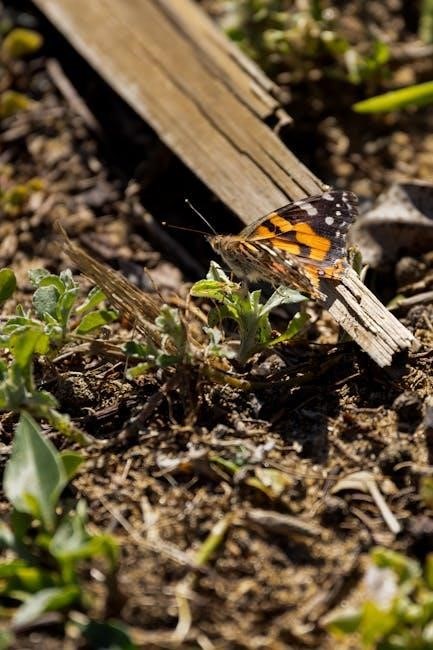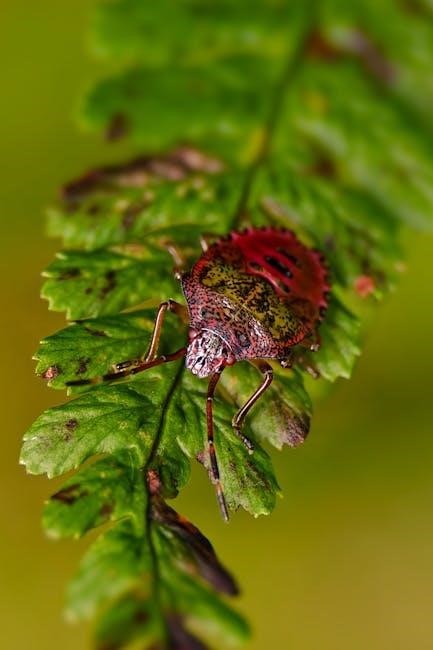Wildlife biology integrates mathematical principles to study ecosystems and species. Essential math skills include algebra‚ statistics‚ and spatial analysis. Resources like PDF guides and textbooks provide foundational learning tools.

Overview of Wildlife Biology as a Field of Study
Wildlife biology is an interdisciplinary field focusing on the study of wild animals and their interactions with ecosystems. It encompasses ecology‚ genetics‚ behavior‚ and conservation biology‚ aiming to understand species’ roles in natural environments.
Mathematics plays a crucial role in wildlife biology‚ enabling researchers to model population dynamics‚ analyze data‚ and make informed conservation decisions. Skills such as algebra‚ statistics‚ and calculus are essential for tasks like predicting population trends and assessing habitat health.
By integrating mathematical tools‚ wildlife biologists can develop effective strategies for species management and environmental sustainability‚ ensuring the preservation of biodiversity for future generations.
The Role of Mathematics in Wildlife Biology
Mathematics is fundamental to wildlife biology‚ providing essential tools for analyzing and understanding ecological systems. It enables researchers to model population dynamics‚ study animal behavior‚ and assess environmental impacts. Key mathematical concepts like algebra‚ calculus‚ and statistics are used to process data‚ predict trends‚ and inform conservation strategies.
Mathematical models help estimate population sizes‚ track migration patterns‚ and evaluate habitat use. Statistical analysis is crucial for interpreting field data‚ while probability theory aids in risk assessments for endangered species. These mathematical applications ensure that wildlife biologists can make data-driven decisions to protect and manage ecosystems effectively.
Core Math Concepts Required for Wildlife Biology
Core math concepts include arithmetic‚ fractions‚ percentages‚ basic algebra‚ and introductory statistics‚ essential for data analysis and problem-solving in wildlife biology studies.

Algebra and Its Applications in Wildlife Biology
Algebra is a fundamental tool in wildlife biology‚ enabling researchers to model population dynamics‚ analyze species interactions‚ and solve equations for habitat and resource management. Variables like population size‚ age‚ and sex structures are often manipulated using algebraic expressions. For instance‚ algebraic equations are used to estimate survival rates‚ birth rates‚ and migration patterns. Linear algebra is applied in species distribution modeling‚ while quadratic equations help in understanding predator-prey relationships. Algebraic techniques also aid in optimizing conservation strategies‚ such as calculating the most efficient placement of wildlife corridors. Proficiency in algebra is essential for interpreting and applying mathematical models in wildlife biology effectively.
Geometry and Spatial Analysis in Wildlife Studies
Geometry and spatial analysis are critical in wildlife biology for understanding the spatial distribution of species‚ habitats‚ and ecosystems. Researchers use geometric principles to analyze shapes‚ distances‚ and patterns in wildlife habitats. Tools like Geographic Information Systems (GIS) rely on geometric concepts to map territories‚ track movements‚ and assess landscape connectivity. Spatial analysis helps identify corridors for migration‚ fragmentation of habitats‚ and optimal locations for conservation efforts. By applying geometric techniques‚ scientists can quantify habitat loss‚ model home ranges‚ and predict species distribution under climate change. These spatial methods are essential for developing effective conservation strategies and managing wildlife populations in diverse ecosystems.

Trigonometry in Wildlife Habitat Analysis
Trigonometry plays a vital role in wildlife habitat analysis by enabling researchers to calculate distances‚ heights‚ and angles in the field. For instance‚ biologists use trigonometric functions to determine the height of trees or the distance to wildlife using angle measurements from known points. This is particularly useful in estimating habitat features‚ such as canopy cover or terrain slopes. Additionally‚ trigonometry aids in analyzing the spatial arrangement of habitats and the movement patterns of animals. It is also essential for interpreting data from tools like camera traps or telemetry devices‚ which often rely on angular measurements. By applying trigonometric principles‚ scientists can create precise models of wildlife habitats‚ aiding in conservation and management efforts. These skills are indispensable for accurate field measurements and data analysis in wildlife biology.

Advanced Math Concepts for Wildlife Biology
Advanced math concepts like calculus and statistics are crucial for analyzing population dynamics‚ ecosystem interactions‚ and conservation strategies in wildlife biology.
Calculus and Its Role in Population Dynamics
Calculus plays a vital role in understanding population dynamics by analyzing rates of change and modeling growth patterns. Derivatives are used to study population growth rates‚ while integrals help estimate total population sizes over time. Differential equations are essential for constructing mathematical models that predict how populations evolve under various environmental conditions. These models often incorporate factors like resource availability‚ predation‚ and disease‚ enabling researchers to identify equilibrium points and forecast future trends. Calculus also aids in optimizing conservation strategies‚ such as determining the most effective interventions to stabilize or increase endangered species populations. By applying calculus‚ wildlife biologists can better understand complex ecological systems and develop data-driven solutions for sustainable wildlife management.
Statistics and Data Analysis in Wildlife Research
Statistics and data analysis are fundamental tools in wildlife research‚ enabling scientists to extract meaningful insights from data. Descriptive statistics‚ such as mean and variance‚ summarize population characteristics‚ while inferential statistics allow researchers to make broader inferences. Hypothesis testing is crucial for evaluating ecological theories‚ such as habitat preferences or migration patterns. Regression analysis helps identify relationships between variables‚ like climate change impacts on species abundance. Advanced techniques‚ such as generalized linear models and Bayesian analysis‚ are increasingly used for complex datasets. Data visualization tools‚ like graphs and heatmaps‚ communicate findings effectively. Accurate statistical methods ensure reliable conclusions‚ guiding conservation efforts and policy decisions. Proficiency in statistical software‚ such as R or Python‚ is essential for modern wildlife biologists to analyze and interpret data effectively.
Probability Theory in Wildlife Population Modeling
Probability theory is essential for modeling uncertain events in wildlife populations‚ such as birth rates‚ mortality‚ and migration. Stochastic processes‚ including Markov chains‚ are used to predict population dynamics under varying conditions. Probability distributions‚ like binomial and Poisson‚ model random events‚ such as species survival or disease outbreaks. Bayesian statistics are applied to estimate parameters and update models with new data. These tools help researchers forecast population trends‚ assess risks‚ and design conservation strategies. Understanding probability theory enables wildlife biologists to quantify uncertainty and make informed decisions. Advanced software‚ such as R and Python‚ facilitates these analyses‚ making probability theory a cornerstone of modern wildlife population modeling and management.
Mathematical Tools for Wildlife Ecology
Mathematical tools like R‚ Python‚ and GIS are essential for wildlife ecology‚ enabling data analysis‚ simulations‚ and spatial modeling to study ecosystems and species interactions effectively.
Mathematical Modeling in Wildlife Ecology
Mathematical modeling is a cornerstone of wildlife ecology‚ allowing researchers to simulate complex biological systems and predict ecosystem behavior. These models often incorporate variables such as population size‚ habitat quality‚ and environmental factors to forecast outcomes. For instance‚ differential equations are used to model population growth and decline‚ while spatial models analyze habitat use and migration patterns. Species distribution models also rely on mathematical frameworks to predict how wildlife responds to climate change or land-use changes. By integrating field data with mathematical principles‚ ecologists can develop robust tools for conservation planning and resource management. Accurate modeling ensures informed decision-making‚ making it a vital skill for wildlife biologists.
Systems of Equations in Ecosystem Analysis
Systems of equations are essential for analyzing the intricate relationships within ecosystems. These equations model interactions between species‚ their environments‚ and resource availability. For example‚ predator-prey dynamics can be represented by coupled differential equations‚ where predator and prey populations influence each other. Similarly‚ nutrient cycling in ecosystems can be described using systems of equations to track energy flow and material exchange. By solving these systems‚ wildlife biologists can predict ecosystem stability‚ identify thresholds for species survival‚ and evaluate the impact of external factors like climate change. This mathematical approach provides a framework for understanding complex ecological processes‚ enabling more effective conservation and management strategies. It bridges theory with practical applications‚ making it indispensable for ecosystem analysis.
Graph Theory in Wildlife Migration Patterns
Graph theory plays a crucial role in analyzing wildlife migration patterns by modeling the connections between key locations. Nodes represent habitats‚ stopover points‚ or breeding grounds‚ while edges symbolize migration routes or interactions. This framework helps researchers understand connectivity‚ optimize corridor designs‚ and identify critical pathways. For instance‚ graph algorithms can determine the shortest path for migratory routes‚ minimizing energy expenditure. Additionally‚ graph theory assesses network robustness‚ identifying vulnerable points that could disrupt migration. It also aids in studying social structures and disease transmission among migratory species. By applying graph theory‚ wildlife biologists can develop strategies to mitigate habitat fragmentation and ensure species survival. This mathematical approach enhances conservation planning and ecological management effectively.

Research Methods in Wildlife Biology
Research methods in wildlife biology combine field observations‚ remote sensing‚ and statistical analysis to study species behavior‚ habitats‚ and populations. Mathematical modeling enhances data interpretation and prediction accuracy.

Quantitative Research Methods in Wildlife Biology
Quantitative research methods in wildlife biology rely heavily on mathematical and statistical techniques to analyze data and draw conclusions. These methods include regression analysis‚ hypothesis testing‚ and confidence interval estimation‚ which require a strong foundation in algebra and statistics. Wildlife biologists use these tools to study population dynamics‚ habitat use‚ and species behavior. For instance‚ regression models help predict population trends based on environmental factors‚ while hypothesis testing determines the significance of observed patterns. Understanding these methods is crucial for interpreting field data accurately and making informed conservation decisions. Math prerequisites‚ such as proficiency in calculus and probability theory‚ are essential for mastering these quantitative approaches. By applying mathematical frameworks‚ researchers can address complex ecological questions effectively.
Mathematical Simulations in Wildlife Conservation
Mathematical simulations play a vital role in wildlife conservation by providing predictive models that guide decision-making. These simulations often involve differential equations and algorithms to model population dynamics‚ habitat use‚ and ecosystem interactions. For instance‚ simulations can predict how a species’ population may decline due to habitat loss or climate change. Wildlife biologists use these tools to design effective conservation strategies‚ such as optimal reserve placement or species reintroduction programs. The development of accurate simulations requires strong mathematical skills‚ including calculus for understanding rate changes and linear algebra for managing complex systems. By integrating field data with mathematical models‚ researchers can create realistic scenarios that inform actionable conservation plans. This approach ensures that limited resources are used efficiently to protect endangered species and ecosystems.
Field Data Collection and Mathematical Analysis
Field data collection is a cornerstone of wildlife biology‚ involving the gathering of information on species behavior‚ population sizes‚ and habitat conditions. This data is then analyzed using mathematical techniques to draw meaningful conclusions. Key math skills include statistical analysis for interpreting population trends and spatial reasoning for mapping habitats. Tools like GIS mapping and remote sensing rely on mathematical algorithms to process data. Understanding descriptive and inferential statistics is crucial for making accurate inferences from field observations. By applying these math skills‚ wildlife biologists can identify patterns‚ test hypotheses‚ and inform conservation strategies effectively. This integration of fieldwork and mathematical analysis is essential for advancing wildlife biology and ensuring data-driven decision-making in conservation efforts.

Practical Applications of Math in Wildlife Biology
Mathematics is essential for analyzing population trends‚ understanding spatial data‚ and developing conservation strategies. It aids in habitat modeling‚ resource management‚ and predicting species responses to environmental changes.
Case Studies: Math in Wildlife Conservation Projects
Mathematics plays a pivotal role in wildlife conservation projects‚ as demonstrated by various case studies. For instance‚ population viability analysis uses mathematical models to predict species survival rates under different scenarios. In one study‚ algebraic equations were employed to estimate the impact of habitat fragmentation on migratory patterns. Another case involved the use of calculus to model disease spread among wildlife populations‚ aiding in the development of vaccination strategies. Spatial analysis‚ leveraging geometric principles‚ helped restore habitats for endangered species like the gray wolf. These examples highlight how mathematical techniques provide actionable insights‚ enabling more effective conservation efforts. Such applications underscore the necessity of strong math skills in addressing real-world ecological challenges.
Mathematical Tools for Wildlife Habitat Restoration
Mathematical tools are essential in wildlife habitat restoration‚ enabling precise and effective restoration strategies. Spatial analysis and Geographic Information Systems (GIS) utilize geometric principles to map and assess habitat areas‚ crucial for identifying restoration sites. Optimization techniques‚ derived from algebra‚ help allocate resources such as water and plant species efficiently‚ ensuring maximum impact with minimal waste. Habitat suitability models employ statistical methods to determine the most favorable areas for species reintroduction‚ enhancing the likelihood of successful restoration. Additionally‚ mathematical algorithms predict the success of restoration efforts based on environmental factors like soil quality and climate conditions. These tools rely on a strong foundation in math‚ underscoring the importance of mathematical proficiency for wildlife biologists involved in habitat restoration projects. By leveraging these techniques‚ conservationists can design and implement more effective restoration plans.
Using Math to Predict Wildlife Population Trends
Mathematics plays a vital role in predicting wildlife population trends‚ which is critical for conservation and management efforts. Exponential and logistic growth models‚ rooted in calculus‚ are used to forecast population sizes over time. These models account for factors like birth rates‚ death rates‚ and environmental limitations. Statistical analysis of historical data helps identify patterns and trends‚ enabling accurate predictions. Population viability analysis (PVA) integrates mathematical simulations to assess the likelihood of extinction or recovery. By applying these tools‚ wildlife biologists can anticipate potential declines or increases‚ informing management decisions to stabilize or restore populations. Mathematical modeling ensures data-driven strategies for species conservation‚ making it indispensable in modern wildlife biology. This approach relies heavily on a strong foundation in algebra‚ calculus‚ and statistics.
Importance of Math in Advancing Wildlife Biology

Future Directions: Integrating Math in Wildlife Research
Advancements in mathematical tools and computational models are expected to revolutionize wildlife biology research. Emerging technologies‚ such as machine learning and artificial intelligence‚ will rely heavily on mathematical frameworks to analyze complex ecological systems. Future research will likely focus on integrating real-time data with predictive models to forecast population trends and habitat changes more accurately. Collaborations between mathematicians and wildlife biologists will be crucial to develop innovative solutions for conservation challenges. Additionally‚ educational programs emphasizing math prerequisites will empower the next generation of researchers to tackle intricate problems in wildlife ecology effectively. This integration will ensure sustainable and data-driven approaches to preserving biodiversity.
Resources for Learning Wildlife Biology Math
Key resources include textbooks‚ online courses‚ and PDF guides‚ providing foundational math skills tailored for wildlife biology applications and research methodologies.
Recommended Textbooks on Wildlife Biology and Math
Several textbooks are highly recommended for mastering the math prerequisites in wildlife biology‚ offering comprehensive coverage of ecological principles and quantitative methods. Titles like Mathematical Ecology by Gotelli and Quantitative Ecology by Hayek provide foundational math concepts tailored for biological applications. Additionally‚ Wildlife Ecology‚ Conservation‚ and Management by Sinclair incorporates statistical and mathematical tools essential for fieldwork. These books are often available as PDFs‚ making them accessible for students. Supplemental PDF guides and worksheets focus on practical exercises to reinforce mathematical skills. Online libraries and university resources frequently offer these materials‚ ensuring accessibility for those preparing for careers in wildlife biology.
Online Courses for Math Prerequisites in Wildlife Biology
Online courses are an excellent way to build the math prerequisites needed for wildlife biology. Platforms like Coursera‚ edX‚ and Udemy offer courses tailored to ecological math‚ such as Mathematical Ecology and Quantitative Methods in Ecology. These courses cover algebra‚ calculus‚ and statistics‚ essential for tasks like population modeling and data analysis. Many universities provide free or low-cost resources‚ including PDF lecture notes and practice problems. Khan Academy also offers foundational math courses that align with wildlife biology needs. These online tools allow students to learn at their own pace‚ ensuring a strong mathematical foundation for advanced wildlife biology studies. They are particularly useful for those seeking flexible learning options to prepare for careers in ecology and conservation.
PDF Guides and Worksheets for Wildlife Biology Math
PDF guides and worksheets are invaluable resources for mastering the math prerequisites in wildlife biology. Many universities and conservation organizations provide free downloadable materials‚ such as Wildlife Biology Math Essentials and Ecological Data Analysis Worksheets. These resources often include practice problems‚ step-by-step solutions‚ and real-world examples tailored to ecology and conservation. Topics range from algebraic equations for population growth to statistical formulas for habitat analysis. Websites like ResearchGate and Google Scholar offer accessible PDFs‚ while platforms like GitHub host open-source math tools for wildlife studies. These materials are ideal for self-study or as supplements to formal coursework‚ helping students apply mathematical concepts to practical wildlife biology scenarios. They are widely available and user-friendly‚ making them a key resource for learners at all levels.
Final Thoughts
Mastering math prerequisites is essential for advancing in wildlife biology‚ enabling accurate data analysis and informed conservation strategies. Strong math skills empower future wildlife biologists to drive meaningful change.

Encouraging Students to Pursue Wildlife Biology with Strong Math Skills
Encouraging students to pursue wildlife biology requires highlighting the importance of math skills in this field. By emphasizing how algebra‚ calculus‚ and statistics are vital for analyzing data‚ modeling populations‚ and understanding ecosystems‚ students can see the practical value of math. Providing resources like wildlife biology math prerequisites PDF guides can help them prepare effectively. Sharing success stories of biologists who use math to conserve species inspires motivation. Encouraging hands-on learning through simulations and fieldwork also bridges the gap between theory and practice. Instilling confidence in their math abilities empowers students to tackle complex challenges in wildlife conservation and research with passion and precision.


